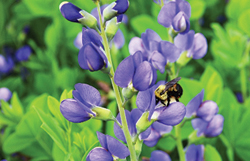May Plant of the Month: Blue False Indigo
Submitted by the Bath Gamma Garden Club
The genus name Baptisia is derived from the Greek word “bapto,” which means to dip or dye. Early American colonists used it as a substitute for true indigo, hence the common name “blue false indigo.”
Baptisia australis is a member of the pea family. It is an upright, herbaceous perennial, native to the Northeastern U.S., zones 3-9. It features violet-blue flowers that resemble Lupines on erect racemes atop flower spikes above densely foliaged plants. They typically grow 3 to 4 feet tall and occur in rich woods, thickets and along stream banks.
They are slow to establish, but well worth the wait when blooming begins in mid-May. Once established, they are drought tolerant. Baptisia have deep roots that do not tolerate being divided, moved or even disturbed once planted. They make a good specimen plant in the border of a perennial, cottage or native plant garden.
Very few pests or diseases prey on wild indigos; though beware of voles that may feed on their roots. They are deer resistant. Pollinators love the violet-blue flowers of baptisia. It is the host plant for many species of butterflies including the Clouded Sulphur butterfly. Flowers give way to an interesting ornamental inflated seedpod, which turns black when ripened. Folklore has it that the pods were once used as a rattle for children. Stems with seedpods attached make interesting additions to dried floral arrangements.
Wild indigos are tolerant of most garden soils but need six hours of full sun to thrive and produce their best show of blooms. Once established, they survive best with dry to medium soil moisture. They benefit from a top dressing of 2 to 3 inches of compost and enjoy a little 10-10-10 fertilizer in spring.
Stan Hywet Hall & Gardens offers a striking display of baptisia australis, wild blue indigo, in the perennial gardens in May. For more information contact bathgammagardenclub@gmail.com or visit gardenclubbathohio.org

